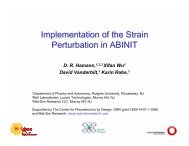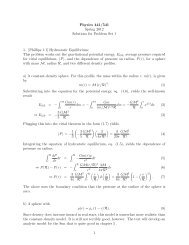7. Interference of Sound Waves
7. Interference of Sound Waves
7. Interference of Sound Waves
Create successful ePaper yourself
Turn your PDF publications into a flip-book with our unique Google optimized e-Paper software.
2011 <strong>Interference</strong> - 1<br />
INTERFERENCE OF SOUND WAVES<br />
The objectives <strong>of</strong> this experiment are:<br />
• To measure the wavelength, frequency, and propagation speed <strong>of</strong><br />
ultrasonic sound waves.<br />
• To observe interference phenomena with ultrasonic sound waves.<br />
APPARATUS: Oscilloscope, function generator, ultrasonic transducers, meter stick,<br />
angle board.<br />
INTRODUCTION<br />
I<br />
n this experiment we deal with sound waves, produced by and detected with ultrasonic<br />
transducers. We study the interference <strong>of</strong> coherent (same phase) waves. The<br />
oscillations are displayed on an oscilloscope.<br />
Sinusoidal waves can be characterized by the following parameters:<br />
Wavelength: ...........................<br />
Frequency:..............................f
2011 <strong>Interference</strong> - 2<br />
Period: ....................................T = 1/f<br />
Wave propagation speed: ......c = f = /T .<br />
The speed <strong>of</strong> sound through air (at 20 C) is approximately 344 m/s.<br />
Ultrasonic transducer<br />
A transducer is a device that transforms one form <strong>of</strong> energy into another, for example, a<br />
microphone (sound to electric) or loudspeaker (electric to sound). In this experiment the<br />
transducer is a "piezoelectric" crystal <strong>of</strong> barium titanate which converts electrical<br />
oscillations into mechanical vibrations that make sound. The oscillating frequency is near<br />
40 kHz which is beyond what can be heard by the human ear (about 20 kHz).<br />
<strong>Interference</strong> <strong>of</strong> <strong>Waves</strong><br />
Below in Figure 1 is a drawing <strong>of</strong> the basic concept for interference <strong>of</strong> coherent waves<br />
from two point sources. Coherent means that the waves, even though they are from<br />
separate sources, have the same frequency and are in lock-step, namely in phase, as they<br />
are being emitted. The waves will get out <strong>of</strong> relative phase because they have to travel<br />
different path lengths to reach the same point in space. There, the waves can add<br />
constructively if they are in phase, or add destructively if they arrive out <strong>of</strong> phase. Look<br />
at the diagram.<br />
FIGURE 1<br />
S1 and S2 are sound wave sources oscillating in phase because they are driven by the<br />
same voltage signal generator; they are separated by distance d. The sources also emit<br />
waves <strong>of</strong> the same frequency. P is the place where we place a detector, fairly far (in terms
2011 <strong>Interference</strong> - 3<br />
<strong>of</strong> d) from S1 and S2 . At point P the path difference to S1 and to S2, is the distance<br />
d sin . When the path difference, d sin is an integral multiple <strong>of</strong> the wavelength ,<br />
waves arriving at P from S1 and S2 will be in phase and will interfere constructively.<br />
Note that constructive interference gives maximum intensity:<br />
d sin<br />
<br />
max<br />
n<br />
where n = 0, 1, 2,-- is referred to as the order <strong>of</strong> the particular maximum.<br />
The Oscilloscope<br />
We have used FFTscope, a virtual oscilloscope, in previous labs. If you're unfamiliar with<br />
the basic operation <strong>of</strong> a real oscilloscope the following should be helpful. Essentially, the<br />
amplitude <strong>of</strong> a quantity (usually Voltage) is plotted on the screen as a function <strong>of</strong> time, in<br />
real-time. It is possible to display one or two channels (quantities) at the same time; in<br />
this lab we monitor Driving Voltage from the transmitting transducer (via the function<br />
generator) and Induced Voltage in the receiving transducers. Here we will monitor the<br />
receiving transducer on Channel 1 (CH 1, yellow trace) and the transmitting transducers<br />
on Channel 2 (CH 2, blue trace).<br />
PROCEDURE:<br />
1. Learn to use the oscilloscope
2011 <strong>Interference</strong> - 4<br />
1. Position the oscilloscope in front <strong>of</strong> you. If you wish you can gently flip out the front<br />
legs so that it is tilted upward for easier viewing. Make sure no cables are plugged into<br />
the front <strong>of</strong> the scope for now (T-connectors are okay though). Press the ON button on<br />
the top left <strong>of</strong> the scope and wait 35-40 seconds for the grid to show on the display<br />
(ignore the Language selection screen). If the scope is already on, press the DEFAULT<br />
SETUP button on the upper-right.<br />
2. You should see two baseline “noise” traces – Yellow for CH1 and Blue for CH2; this<br />
is merely background noise since nothing is yet plugged into the scope.<br />
a. Experiment with adjusting the vertical position <strong>of</strong> both traces by adjusting the Vertical<br />
Position knobs above the CH1 Menu and CH2 Menu buttons – this will allow you to<br />
arrange your plots so that they are not on top <strong>of</strong> one another. There is also a Horizontal<br />
Position knob above the SEC/DIV knob. This allows one to move the traces left or right.<br />
b. Now fiddle with the Sec/Div knob – this sets the size <strong>of</strong> your time window (horizontal<br />
axis). If you set the value (look at the “M” value at the bottom-center <strong>of</strong> the screen) to<br />
something like 500ms, it'll look like one <strong>of</strong> those patient monitoring displays at the<br />
hospital. The M value is the time interval per square. Note that this scope will let you<br />
examine a time window on the order <strong>of</strong> a few nanoseconds – an extremely short<br />
interval <strong>of</strong> time.<br />
c. Restore the Sec/Div knob to some intermediate value and now adjust the Volts/Div on<br />
each channel – this adjusts the gain, or sensitivity <strong>of</strong> the trace on the vertical axis (i.e.<br />
potential difference per square). At the highest setting the traces will fluctuate wildly (but<br />
randomly); at the lowest setting they'll be relatively calm.<br />
2. Measuring frequency
2011 <strong>Interference</strong> - 5<br />
The setup is shown in Fig. 2 (note that Chnl B in the figure is Ch 2 on the oscilloscope,<br />
and Chnl A is Ch 1): a variable frequency signal generator drives one ultrasonic<br />
transducer; its output is also applied to channel 2 (blue trace) <strong>of</strong> the oscilloscope. (Later<br />
in the experiment two transmitting transducers will be connected to channel 2.) The<br />
output <strong>of</strong> a second receiving ultrasonic generator is applied to channel 1 (yellow trace) <strong>of</strong><br />
the scope. Channel 2 trace (pattern <strong>of</strong> the oscilloscope) shows the sinusoidal voltage<br />
applied to the transmitting generator; channel 1 trace shows the sinusoidal voltage<br />
coming out <strong>of</strong> the receiving ultrasonic crystal.<br />
Dual Trace<br />
Oscilloscope<br />
Chnl B<br />
Chnl A<br />
Function<br />
Generator<br />
Receiv er<br />
Transmitter<br />
FIGURE 2<br />
Plug the cables into the appropriate channels as pictured in Figure 2 above. Make sure<br />
that initially only one <strong>of</strong> the transmitting transducers is connected to the T-connector.<br />
Turn on the function generator by pressing the green power button.<br />
Adjust the scope controls: vertical amplification (Volts/Div), horizontal sweep rate<br />
(Sec/Div), vertical position, and horizontal position so that trace 1 shows several, steady<br />
sine curves. Place the transmitting transducer facing the receiver at a distance <strong>of</strong> a few<br />
centimeters. If you think the transducers are not functioning (nothing on trace 1), it is<br />
most likely that the function generator is not at the exact resonance frequency. You<br />
should tune to resonance when the signal getting through to the receiving transducer<br />
(trace 1) reaches a maximum. Do this by varrying the frequency around 38 to 42 kHz. Be<br />
aware that a small red light on the display <strong>of</strong> the function generator will light up “kHz” if<br />
the reading is in kHz (as opposed to Hz). This is, <strong>of</strong> course, what you want. You can see<br />
that sound signal is being received by placing your hand in front <strong>of</strong> the transducers. By<br />
blocking the sound wave, you will disturb or eliminate the yellow trace from Ch 1.
2011 <strong>Interference</strong> - 6<br />
Warning: Do not exchange your transducers with those from other tables;<br />
your three transducers are a matched set.<br />
Measure the period <strong>of</strong> oscillation directly from the oscilloscope's screen, taking into<br />
account the sweep rate (“M” value at bottom-center <strong>of</strong> screen). To make the period<br />
measurement as accurate as possible, measure the time interval corresponding to several<br />
complete oscillations. That is, measure the total time interval and divide by the total<br />
number <strong>of</strong> waves. Use the fine rulings <strong>of</strong> the square boxes to obtain a precise value. The<br />
reciprocal <strong>of</strong> T is f. Compare the frequency fo determined with the oscilloscope with both<br />
the frequency fsg <strong>of</strong> the signal generator and the frequency provide by the oscilloscope in<br />
blue in the lower right corner <strong>of</strong> the screen. The latter two values will likely be more<br />
accurate than your computed value, but the point is to gain an understanding <strong>of</strong> the<br />
information conveyed by the oscilloscope traces.<br />
A more precise way to measure the period, which exploits special features <strong>of</strong> the<br />
oscilloscope is as follows. Press the Cursor button near the middle <strong>of</strong> the dozen buttons<br />
at the top <strong>of</strong> the face <strong>of</strong> the scope – this will now change the on-screen Menu on the right<br />
<strong>of</strong> the scope screen. The Menu selections can be made by pressing on the buttons<br />
immediately to the right <strong>of</strong> the screen; press the button to the right <strong>of</strong> Type (twice) so that<br />
the Time cursors are activated. Beneath Type the word “TIME” will appear in a white<br />
box, and you should now see two vertical lines on the screen. If beneath Source you see<br />
“Ch 1” or “Ch 2” the vertical lines will be yellow or blue respectively. Either will do<br />
since both traces pertain to waves <strong>of</strong> the same frequency and period. However, if you see<br />
neither “Ch 1” nor “Ch 2” you will need to press the button to the right <strong>of</strong> Source until<br />
you are in one <strong>of</strong> these settings. Turn the knobs labeled VERTICAL Position CURSOR 1<br />
and CURSOR 2 (i.e. the knobs which usually move the traces the left and right) to move<br />
the vertical lines left and right. Align one with a wave crest (or trough) to the left <strong>of</strong> the<br />
screen and one with a wave crest (or trough) to the right <strong>of</strong> the screen. Then the read out<br />
on the right <strong>of</strong> the screen in blue or yellow will say DELTA beneath which will read the<br />
time interval between the vertical lines. This information can also be extracted from the<br />
difference in time values listed for Cursor 2 and Cursor 1 just below DELTA. You need<br />
only divide by the number <strong>of</strong> wave cycles in order to determine the period.<br />
3. Measuring wavelength<br />
The transmitting and receiving transducer stands fit over, and can slide along, a meter<br />
stick. With both transducers fixed in position, the two sinusoidal traces on the scope are<br />
steady. What happens to the scope trace from the receiving transducer when you move<br />
the receiving transducer away from the transmitting transducer? The traces are providing<br />
information about the relative phases <strong>of</strong> the transmitted and received sound wave (or the<br />
driving voltage and receiver voltage).<br />
Measure the wavelength by slowly shifting the receiving transducer a known distance<br />
away from the transmitter while noting on the oscilloscope screen by how many complete<br />
cycles <strong>of</strong> relative phase the wave pattern shifts. Don't choose just one cycle, but as many<br />
cycles as can conveniently be measured along the meter stick.
2011 <strong>Interference</strong> - 7<br />
4. Calculating Speed <strong>of</strong> <strong>Sound</strong><br />
Use the measured period <strong>of</strong> ultrasonic oscillations from Part 2 and the wavelength from<br />
Part 3 to compute the speed <strong>of</strong> sound through air. Then repeat the calculation using the<br />
frequency from the signal generator. The oscillation period measured with the scope<br />
sweep calibration may not be as accurate as the frequency readings on the signal<br />
generator or oscilloscope display. Compare your computed values with the standard<br />
value <strong>of</strong> 344 m/s for dry air at 20 C temperature. Then consider which is more accurate<br />
and why.<br />
5. Double Source <strong>Interference</strong><br />
The setup is similar to Fig. 2, but another transmitting transducer is added. This is<br />
effected by plugging the cable <strong>of</strong> the second transmitter into the T-connector and<br />
centering the pair <strong>of</strong> transmitters on the board (they are attached by a magnet at their<br />
base, which can slide). The pair <strong>of</strong> transmitters are placed side-by-side and driven in<br />
phase by a signal generator; a third receiving transducer is at an angle which can be<br />
varied. See Fig. 3, which duplicates the arrangement shown in Fig. 1.<br />
FIGURE 3<br />
We are interested in observing the amplitude <strong>of</strong> the resultant ultrasonic wave reaching the<br />
receiving transducer. When you move the detector you are receiving the combined<br />
intensity <strong>of</strong> the two interfering waves. Sometimes you will see a strong signal while other<br />
times little or none. Move the receiving transducer along a circular arc, maintaining a<br />
constant distance from the two transmitting transducers. Record the transmitter<br />
separation d and the angular positions max for interference maxima. The separation<br />
between transmitters should be kept as small as possible, while the distance <strong>of</strong> the<br />
receiver should be as large as possible. However, you may have to compromise on the<br />
inter-transmitter distance you choose since fewer maxima will be observable for smaller<br />
distances. For this reason, it may not be possible to see the fourth order maximum.<br />
Suggestion: rather than plotting max readings directly from the protractor, try taking<br />
corresponding left-side and right-side values and average them, thus eliminating any error<br />
in judging where the center line is.
2011 <strong>Interference</strong> - 8<br />
Confirm the constructive interference relation, n = d sinmax, by plotting sin max as a<br />
function <strong>of</strong> the integer n. (Take values for n and max on the right side as positive and<br />
those on the left as negative so your plot is a straight line (sin = -sin) rather than a<br />
"V"). The slope <strong>of</strong> your best straight line will enable you to calculate /d, and then the<br />
wavelength in terms <strong>of</strong> the measured distance, d, between the transmitters. Compare<br />
this with the value <strong>of</strong> measured in part 4. Obviously the slope will also give you d/.<br />
Thus you can find the separation d in terms <strong>of</strong> the theoretical wavelength = c/f.<br />
Compare this with the value <strong>of</strong> d directly measured.
2011 <strong>Interference</strong> - 9<br />
INTERFERENCE OF SOUND WAVES<br />
LAB REPORT FORM<br />
Name:___________________________________________________ Section:________<br />
Partner: _____________________________________________________Date: _______<br />
2) Frequency Measurement<br />
Oscilloscope Time Base Per Div (TB): __________<br />
Number <strong>of</strong> <strong>Waves</strong> Counted on Screen (NW):_________<br />
Number (& fractional parts) <strong>of</strong> Divisions Covered by <strong>Waves</strong> (ND): ________<br />
Period <strong>of</strong> One Wave = TB * ND / NW = _________ Frequency = _________<br />
Frequency from signal generator, = __________<br />
Frequency from oscilloscope display = __________<br />
3) Wavelength Measurement<br />
Number <strong>of</strong> <strong>Waves</strong> Moved on Oscilloscope Nw: _________<br />
Initial Position <strong>of</strong> Movable Sensor Pi: __________<br />
Final Position <strong>of</strong> Movable Sensor Pf: ___________<br />
Distance sensor moved, Pi - Pf = D: _____________<br />
Length <strong>of</strong> One Wave, Wavelength = D/Nw : ___________<br />
What happens to the scope trace from the receiving transducer when you move the<br />
receiving transducer away from the transmitting transducer? How does this allow you to<br />
calculate wavelength? Explain.<br />
4) Speed <strong>of</strong> <strong>Sound</strong>: Use your wavelength and frequency (as determined with<br />
oscilloscope) to calculate c. Do the same with the function generator frequency.<br />
c = = _____________ c = =_____________<br />
Compare your computed values with the standard value <strong>of</strong> 344 m/s for dry air at 20 C<br />
temperature. Which is better?
2011 <strong>Interference</strong> - 10<br />
5) <strong>Interference</strong> <strong>of</strong> <strong>Sound</strong> Separation <strong>of</strong> Sources, d: _________<br />
max sin(max) n (maximum #)<br />
Graph sin(max) vs. n. Measure slope <strong>of</strong> line fitted to data.<br />
slope = /d = ______ (recall, n = d sinmax)<br />
use measured d to get _____<br />
Compare wavelength measured on the oscilloscope (Part 3) with the value from<br />
interference (Part 5):<br />
R (ratio) = oscint = __________<br />
The slope <strong>of</strong> your best straight line also enables you to calculate (d/), and thus the<br />
separation d in terms <strong>of</strong> the theoretical wavelength = c/f. Use the theoretical value <strong>of</strong> c<br />
and the value <strong>of</strong> frequency which gave the most accurate speed in part 4 to compute<br />
lambda. Compare this with the value <strong>of</strong> d directly measured.


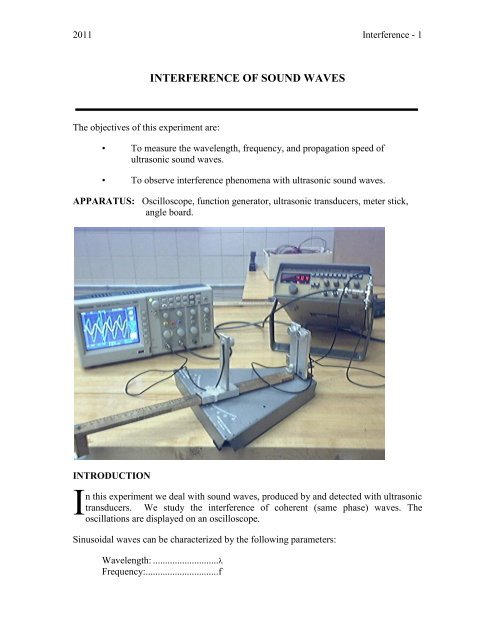

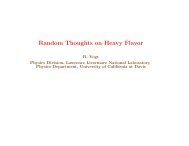
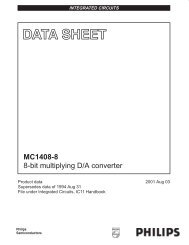

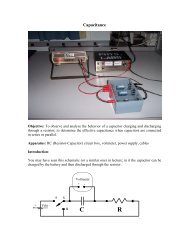


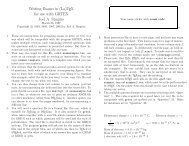
![More Effective C++ [Meyers96]](https://img.yumpu.com/25323611/1/184x260/more-effective-c-meyers96.jpg?quality=85)

